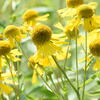About Native Plants
Native plants are those plants which evolved and thrived in our region before European settlers arrived, bringing new and sometimes invasive species.
Why Use Native Plants?
Ecological reasons. Native plants create habitat for indigenous wildlife. Our native birds, animals, butterflies, and other insects depend on these plants for their food and shelter. Native flowers bloom and fruit ripens in symbiotic relationships with the needs of the animals that pollinate the flowers and disperse the seeds. Planting native plants helps increase biodiversity which is essential for sustaining the health of our natural ecosystems.
Economic reasons. Native plants are adapted to our local climate, soils, and moisture conditions. Therefore, they require less maintenance, fertilizer, pesticides, and supplemental watering, making them very effective garden plants. They are also valuable for restoring riparian buffers, wetlands, and other sensitive areas because they stablilize soil and prevent erosion, absorb storm water, and purify air, soil, and water.
Historical reasons. Native plants are our natural inheritance and give us a sense of our own unique region. Using these plants connects us to our region's natural history and helps us preserve a heritage that we are in danger of losing.
Aesthetic reasons. Native plants provide beauty in our gardens and landscapes throughout the seasons. They offer a broad palette of colorful flowers and foliage textures for sun and shade. In the spring, native trees such as eastern redbud are covered with blossoms. Chokeberry and winterberry bear ornamental fruit. Some native plants, including blueberries, persimmons, serviceberries, and pawpaws, bear edible fruit. Black gum, Virginia willow, and red maple have brilliantly colored fall foliage. Some native plants are evergreen like American holly and eastern redcedar, while others, like baldcypress and sycamore, have distinctively textured bark for winter interest.

